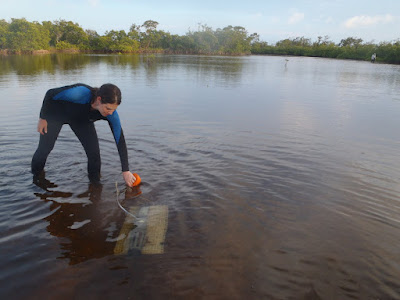Belize Expedition, 2011
One of my favorite things about Carrie Bow is the opportunity to overlap on-island with other scientists. Last week, we had the pleasure of overlapping with an old friend of mine (Dr. Keryn Gedan) who is now a postdoc at the Smithsonian Environmental Research Center in Edgewater, MD. She was here with her adviser, Dr. Denise Breitburg, and her labmate, Rebecca Burrell. These 3 scientists were on Carrie Bow to research mangrove ponds on nearby Twin Cays. I'm delighted that they've written a guest blog to share their experience; totally different from ours!
Their work with mangroves is particularly relevant to the Aquarium, since visitor can come experience a mangrove habitat at The Trust Family Foundation Shark and Ray Touch Tank. But even though you will see upside-down jellies, you won't have to trudge through floc, I promise. :-)
-Randi-
_________
From Rebecca, Keryn, and Denise:
Rebecca Burrell, Dr. Keryn Gedan and Dr. Denise Breitburg
Those familiar with the tropics know that the mangrove forest is an exciting ecosystem, with new and fascinating organisms in every nook and cranny. This is even more true below the water line. If you dip your head into the water for a snorkel to peer at the mangrove roots, you’ll see colors as bright and a community as diverse as on a coral reef growing there. Daunted by the tangle of aerial prop roots that snake across the mangrove forest floor (red mangroves grow aerial roots to enable them to live in very low oxygen soils), however, most people admire the community from the forest fringe. Not us.
We’ve spent the week exploring and studying the interior ponds in a mangrove forest in Belize
The pond waters are still, and they can become scorching hot during the day. On multiple occasions, we documented water temperatures above 100°F in the shallower ponds. Imagine a very warm bath, full of soft, pudding-like mud. Depending on your point of view, this could sound like an expensive spa or the last place you’d imagine visiting, especially with coral reefs so nearby.
And yet, even there, life finds a way. We found a variety of fish species that inhabit the ponds, even during these extreme temperature peaks. Though the fish communities were not as diverse as a reef, we were surprised to find large, predatory fish, including nurse shark, barracuda, stingrays and snappers, in the deeper ponds.
Another common pond resident is the upside-down jellyfish, Cassiopea xamachana, a colorful, flower-resembling jellyfish that lives, bell down, on the pond bottom. Like corals, the upside-down jellyfish has a dinoflagellate symbiont in its tissues that photosynthesizes and provides the jellyfish with most of its nutrition. However, the jellyfish gain additional nutrition in the normal jellyfish way, with stinging cells, which stung us too when we disturbed them to survey their densities in the ponds.
Upside-down jellyfish Cassiopea xamachana
Despite all the floc, heat and jellyfish stings, the ponds are beautiful and a novel study system. Well worth these trials for scientific exploration and discovery!
- Rebecca, Keryn and Denise








This one is definitely going on the NEAq volunteer clipboard. It helps bring our new exhibit to life.
ReplyDelete"Floc!" Who knew!